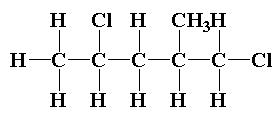
How does one tell if a compound is optically active or inactive by looking at it? For example : 1,4-dichloro-2-methylpentane and 1,2-dichloro-2-methyl pentane.
Answer
543.9k+ views
Hint: The optically active compounds are those which can rotate the plane polarized light. All chirals compounds have the capability of optical rotation. The chiral compounds are those where the carbon atom is attached to four different atoms or groups.
Complete step by step answer:
The compounds which are capable of optical rotation are said to be optically active compounds. All the chiral compounds are optically active.
The chiral compound contains an asymmetric center where the carbon is attached with four different atoms or groups. It forms two non-superimposable mirror images.
The structure of 1,4-dichloro-2-methylpentane is shown below.

In 1,4-dichloro-2-methylpentane, two chiral carbons are present. The C2 carbon and C4 carbon are the chiral carbon present which are attached with four different groups.
The C2 carbon is attached to H, $C{H_3}$, $C{H_2}Cl$and $C{H_2}CHClC{H_3}$.
The C4 carbon is attached to H, Cl, $C{H_3}$ and $C{H_2}CH(C{H_3})C{H_2}Cl$.
So, the compound 1,4-dichloro-2-methylpentane is optically active in nature.
The structure of 1,2-dichloro-2-methylpentane is shown below.

In 1,2-dichloro-2-methylpentane C2 carbon is the chiral carbon.
The C2 carbon is attached to four different atoms or groups.
The C2 carbon is attached to $C{H_3}$, Cl, $C{H_2}Cl$ and $C{H_2}C{H_2}C{H_3}$.
So, the compound 1,2-dichloro-2-methylpentane is optically active in nature.
Note:
When two non-superimposable mirror images are formed by the chiral compounds, then the compounds are said as enantiomers of each other. They are mirror images of each other.
Complete step by step answer:
The compounds which are capable of optical rotation are said to be optically active compounds. All the chiral compounds are optically active.
The chiral compound contains an asymmetric center where the carbon is attached with four different atoms or groups. It forms two non-superimposable mirror images.
The structure of 1,4-dichloro-2-methylpentane is shown below.

In 1,4-dichloro-2-methylpentane, two chiral carbons are present. The C2 carbon and C4 carbon are the chiral carbon present which are attached with four different groups.
The C2 carbon is attached to H, $C{H_3}$, $C{H_2}Cl$and $C{H_2}CHClC{H_3}$.
The C4 carbon is attached to H, Cl, $C{H_3}$ and $C{H_2}CH(C{H_3})C{H_2}Cl$.
So, the compound 1,4-dichloro-2-methylpentane is optically active in nature.
The structure of 1,2-dichloro-2-methylpentane is shown below.

In 1,2-dichloro-2-methylpentane C2 carbon is the chiral carbon.
The C2 carbon is attached to four different atoms or groups.
The C2 carbon is attached to $C{H_3}$, Cl, $C{H_2}Cl$ and $C{H_2}C{H_2}C{H_3}$.
So, the compound 1,2-dichloro-2-methylpentane is optically active in nature.
Note:
When two non-superimposable mirror images are formed by the chiral compounds, then the compounds are said as enantiomers of each other. They are mirror images of each other.
Recently Updated Pages
Master Class 12 English: Engaging Questions & Answers for Success

Master Class 12 Business Studies: Engaging Questions & Answers for Success

Master Class 12 Economics: Engaging Questions & Answers for Success

Master Class 12 Social Science: Engaging Questions & Answers for Success

Master Class 12 Maths: Engaging Questions & Answers for Success

Master Class 12 Chemistry: Engaging Questions & Answers for Success

Trending doubts
What are the major means of transport Explain each class 12 social science CBSE

Which are the Top 10 Largest Countries of the World?

Draw a labelled sketch of the human eye class 12 physics CBSE

Explain sex determination in humans with line diag class 12 biology CBSE

The pH of the pancreatic juice is A 64 B 86 C 120 D class 12 biology CBSE

Explain sex determination in humans with the help of class 12 biology CBSE




